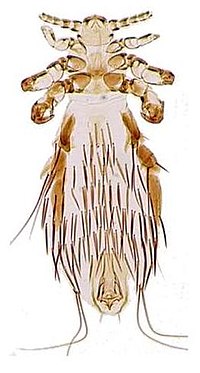Lice
| Phthiraptera | |
|---|---|
 |
|
| Light micrograph of Fahrenholzia pinnata | |
| Scientific classification | |
| Kingdom: | Animalia |
| Phylum: | Arthropoda |
| Class: | Insecta |
| Subclass: | Pterygota |
| Infraclass: | Neoptera |
| Superorder: | Exopterygota |
| Order: |
Phthiraptera Haeckel, 1896 |
| Suborders | |
Anoplura
Rhyncophthirina
Ischnocera
Amblycera
Louse (plural: lice) is the common name for members of the order Phthiraptera, which contains nearly 5,000 species of wingless insect. Lice are obligate parasites, living externally on warm-blooded hosts which include every species of bird and mammal, except for monotremes, pangolins, bats and cetaceans. Lice are vectors of diseases such as typhus.
Chewing lice live among the hairs or feathers of their host and feed on skin and debris, while sucking lice pierce the host's skin and feed on blood and other secretions. They usually spend their whole life on a single host, cementing their eggs, which are known as nits, to hairs or feathers. The eggs hatch into nymphs, which moult three times before becoming fully grown, a process that takes about four weeks.
Humans host three species of louse, the head louse, the body louse and the pubic louse. The body louse has the smallest genome of any known insect; it has been used as a model organism and has been the subject of much research.
Lice were ubiquitous in human society until at least the Middle Ages. They appear in folktales, songs such as The Kilkenny Louse House, and novels such as James Joyce's Finnegans Wake. They commonly feature in the psychiatric disorder delusional parasitosis. A louse was one of the early subjects of microscopy, appearing in Robert Hooke's 1667 book, Micrographia.
...
Wikipedia
